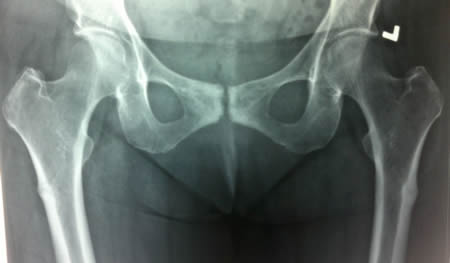Epidemiology
Acute long bone fractures primarily result from significant trauma. Motor vehicle accidents, sport injuries, falls, and assaults are among the most common causes of these injuries. The annual incidence of fractures in Britain is about 3.6%, with 1.8 million fractures occurring in England each year.[12]
The tibia is the most frequently fractured long bone in humans, and may account for 6.6% of all fractures.[1] Femoral shaft fractures may account for 4.5% of all fractures, distal radius fractures for 3.9%, distal femoral fractures 2%, and humeral shaft fractures 1.5%. In a prospective study of the incidence of fractures in Scotland, femoral shaft fractures were found to be relatively uncommon, with a reported incidence of approximately 1 to 4 fractures per 10,000 people per year.[13] Acute femoral shaft fractures are more common among young men, as well as women over the age of 65 years.[13]
As global standards of living and lifespan have increased, so too have osteoporotic fractures and fractures associated with chronic disease. In patients with chronic renal failure, risk factors for fracture include female sex, advanced age, and diabetes, whereas black people and those with increased body mass index seemed to be protected.[14] Among dialysis patients, long bone fracture is associated with increased risk of stroke, pulmonary embolism, congestive heart failure, pneumonia, and septicaemia.[14][15]
Risk factors
Most common cause of long bone fracture, especially in young people. Risk increases with high-energy trauma such as motor vehicle accidents or falls from a great height.
Torsional forces and twisting injuries may result in spiral fractures.
Classically thought of as a risk factor among post-menopausal women. However, incidence of osteoporosis in men is higher than previously thought, especially among those who have undergone androgen deprivation therapy and/or prolonged use of corticosteroids.[35] Increased risk for acute insufficiency fracture with relatively minor trauma.
Increased risk for acute pathological fracture with relatively minor trauma.
Aside from increasing likelihood of low bone mineral density, older people are more prone to falls, a leading cause of fracture.
Younger patients are at a higher risk of high-energy trauma, acute fractures, and stress fractures.
Risk factor for insufficiency fractures.
Risk factor for insufficiency fractures.
Risk factor for fractures in older or osteoporotic patients.
Risk factor for insufficiency fractures.
Risk factor for proximal humerus fracture if there is acute pain or deformity after the seizure.
Data suggest that long term use of bisphosphonates may increase the risk for subtrochanteric, femoral shaft, and rare atypical femoral fractures.[36] A prospective cohort study found that the risk of atypical fracture increased with longer duration of bisphosphonate use in women, particularly beyond 5 years of use.[37] This risk rapidly decreased after bisphosphonate discontinuation. The absolute risk of atypical femur fracture remained very low compared with reductions in the risk of hip and other fractures with bisphosphonate treatment, although the risk-benefit balance appeared less favourable for Asian women.[37] [Figure caption and citation for the preceding image starts]: Bilateral insufficiency lesions in proximal femora in a 63-year-old woman taking weekly alendronate [Citation ends].
Associated with a slightly increased fracture risk.[14]
Associated with a slightly increased fracture risk.
Men have a higher incidence of acute fractures.
Women may have a higher risk for stress and insufficiency fractures.
Use of this content is subject to our disclaimer